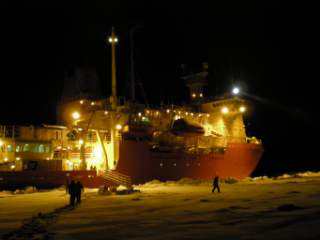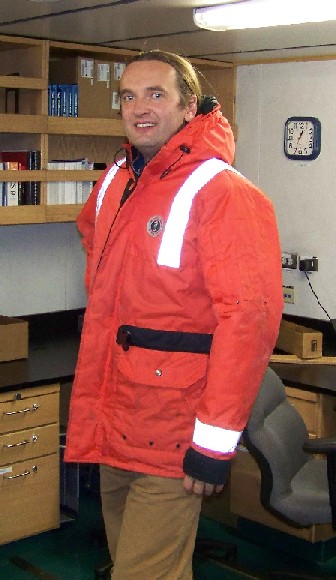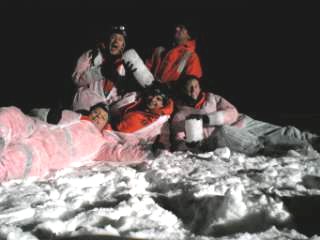**Location: **In the pack ice, in the Bellingshausen Sea, in transit to our multi-week drift station.
Latitude: 70° 38¢ S Longitude: **90°42¢ W **Air temperature: - 3.7°C (25°F) Water temperature: -1.8°C (29°F) Relative humidity: 74% Barometric pressure: 945 mBar
**Antarctic trivia **(answer at the end of this journal entry): What is the largest seal on Earth?
Crunch! Crunch! Sloosh! Crunch! Sloosh! Such were the sounds of my boots when I stepped off the ship onto the ice for the first time. "Crunch” was their call when the snowfall on top of the ice had formed a firm crust, "sloosh” when it wasn’t so firm and my foot sank through the knee-deep snow layer to the ice. Though there were more than a dozen of us on the ice, I heard these sounds clearly in the still night. This was my first experience on the ice in Antarctica, and I was keenly aware of my surroundings.
Not like a September evening at home – no crickets, no rustling leaves, no sounds of civilization; just quiet all around. There was so little wind that the exhaust from the ship hung in the air. Clouds filled the sky, so we didn’t see any stars, but a hazy moon peeked through the clouds. It was just past 1:00 A.M., and we had stopped an hour before to position the ship for our third in-transit ice station. Spotlights from the ship illuminated our work area, and we wore headlamps to see our instruments and field books, so there was plenty of light to work.
 The Palmer provided light for our work on the ice.
The Palmer provided light for our work on the ice.
The temperature was cold by Texas standards, but it was a balmy night for Antarctica – negative 4°C (25°F). I had on several layers of clothing, plus a "float coat” on top, so I didn’t feel cold. Though the chances of falling through the ice are very small, we always wear some type of flotation on the ice. Float coats are jackets that will act as a life preserver in the water. They also have strips of reflective material so that you are easy to see. Though they don’t meet everyone’s standards of fashionable wear, they are essential for ice work.
 Jeroen models the ever stylish float coat.
Jeroen models the ever stylish float coat.
I learned tonight that leather gloves that would be very warm at home are not particularly useful in Antarctica. After about fifteen minutes of work in these gloves my fingers were already stinging from the cold, so I returned to the ship to exchange my gloves for something more practical. New gloves in hand, I was ready to go back to work.
The geophysics team I am working with is interested in measuring and analyzing the physical properties of the ice and snow. My part of the group gathered data along a 100 meter transect line. We measured the depth of the snow at each meter along the line, then went back and measured the thickness of the ice at the same places. That sounds like a pretty easy thing to do, until you consider that to measure the thickness of the ice you need a hole in the ice! That’s where the ice drills, and a lot of manpower (yes, I really mean man, as in male!) came in.
We used hand-crank drills to create one-inch diameter holes through the ice every five meters along our line. I use the word "we” a literally liberally here. My partner John drilled the first hole and made it look easy. We measured the ice thickness (74 cm) and moved five meters up the tape. Not one to shy away from hard work, I figured it was my turn to drill. I quickly realized that I was getting nowhere! I’m no shrinking violet and am not one to give up easily, but after about five minutes and only a small pile of ice shavings to show for my efforts, I sheepishly handed the drill back to John. Luckily for me, he had anticipated this, as his partner at the two previous ice stations had done the same thing. Oh well Penny, at least we tried! Penny and I are grateful for John’s hard work and admire his skill in ice drilling! (Do you think that is enough flattery to convince him to drill the rest of the holes we need?)
Other groups on the ice were taking samples of the ice, snow, and slush to analyze in the lab. The group of researchers from Belgium is analyzing the biogeochemistry of the ice. That’s a mouthful to say, and I’ll tell you a lot more about their work in future journal entries. Their samples must be perfectly clean and can have no contamination from outside sources, so they mark off a special area on the ice that no one else can enter. They also wear "clean” suits over their clothing to prevent contamination of their samples.
 The Belgian group poses with their ice cores. They look happy to be off the ship for a while!
The Belgian group poses with their ice cores. They look happy to be off the ship for a while!
When I returned to the ship I was describing to Sharon (who is from New York and has seen lots of snow) what it had been like on the ice. I told her that walking through the snow wasn’t easy - that it felt like walking in soft sand at the beach. Our conversation made me think about how we learn things. When we experience new things, we think about how they are alike or different from "old” things that we have done. New experiences are related to old experiences, that’s how we make sense of the world around us. Having lived in Texas the past thirty years, I definitely have more experience with sand than snow!
So, here’s your "try this” today…go out and try something new! Really experience it, feel it with all your senses. How can you relate this "new” thing to something that you already know? How is it different? How is it the same? I think all of your experiences are stored in your brain waiting for connections to new things. What do you think?
**Answer to today’s Antarctic trivia question: **What is the largest seal in the world?
The largest seal in the world is the Southern Elephant seal. Males weigh up to 4000 pounds, females up to 1000 pounds. They are called elephant seals not only because of their large size, but also because the male has a large trunk-like "nose” that is inflatable!

